9 Shakespeare Paintings by John Everett Millais
Back in 1590, when Henry IV first appeared on stage, Shakespeare could not have foreseen the popularity of his creations. The appeal of characters...
Ledys Chemin, 23 April 2024
Hardly any author has been such a rich source of literary inspiration for the visual arts as Dante Alighieri. His two major works, the La Vita Nuova and the Divine Comedy gave birth to various artistic traditions and currents. The Divine Comedy, Dante’s majestic epic poem, considered one of Italy’s national treasures, for centuries has been an inexhaustible inspiration for sculptors, painters, and artists such as Wiliam Blake, Gustave Doré, or Salvador Dalí. In order to celebrate the 700th anniversary of the poet’s death through art, let’s dive deep into 15 great artworks depicting Dante or inspired by the stories of the macabre Inferno, righteous Purgatory, and well-earned Paradise.
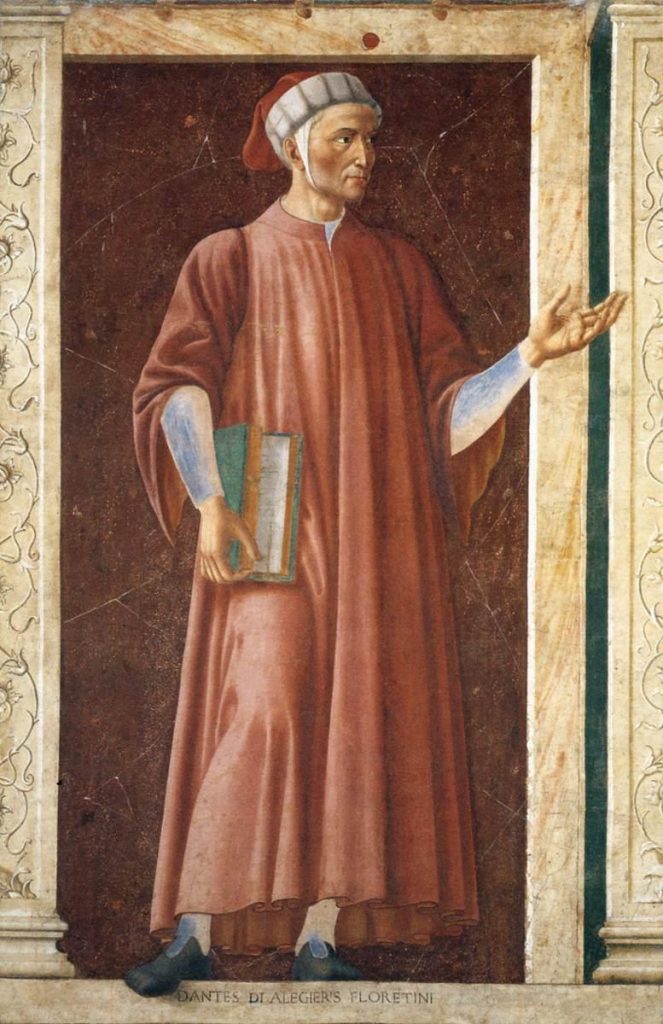
Those who already know Dante and his Divine Comedy can skip this introduction and go directly to the artworks. For those who haven’t had a chance to learn about Dante yet, his full name was Dante Alighieri (1265-1321) and he was an Italian poet, prose writer, literary theorist, moral philosopher, and political thinker. The Italians called him Il Sommo Poeta which could be translated in English as “The Supreme Poet”. He is best known for his monumental epic poem La Commedia, later renamed by Giovanni Boccaccio to La Divina Commedia – The Divine Comedy.
Dante’s Divine Comedy, a landmark in Italian literature and among the greatest works of all medieval European literature, is a profound Christian vision of humankind’s temporal and eternal destiny. On its most personal level, it draws on Dante’s own experience of exile from his native city of Florence. On its most comprehensive level, it may be read as an allegory, taking the form of a journey through the Inferno (Hell), Purgatorio (Purgatory), and Paradiso (Paradise).
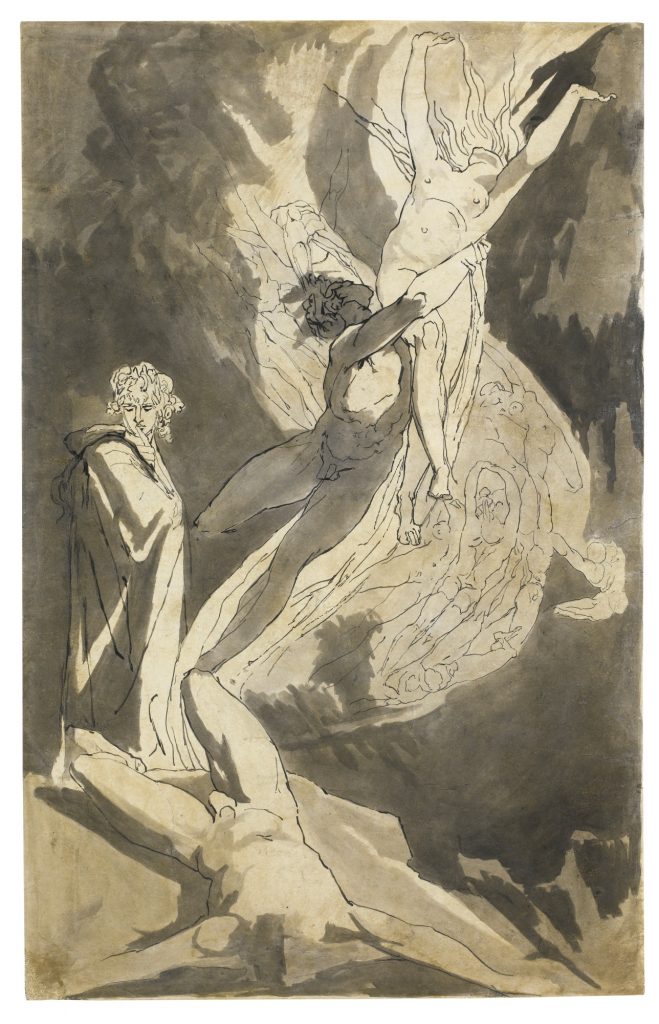
The poem amazes by its array of learning, its penetrating and comprehensive analysis of contemporary problems, and its inventiveness of language and imagery. It was possibly begun prior to 1308 and completed just before Dante’s death in 1321, but the exact dates are uncertain.
The basic structural component of the Divine Comedy is the so-called canto. The poem consists of 100 cantos in total, which are grouped together into three sections, or canticles: Inferno, Purgatorio, and Paradiso. Technically there are 33 cantos in each canticle and one additional canto called Proemio, contained in the Inferno, which serves as an introduction to the entire poem.
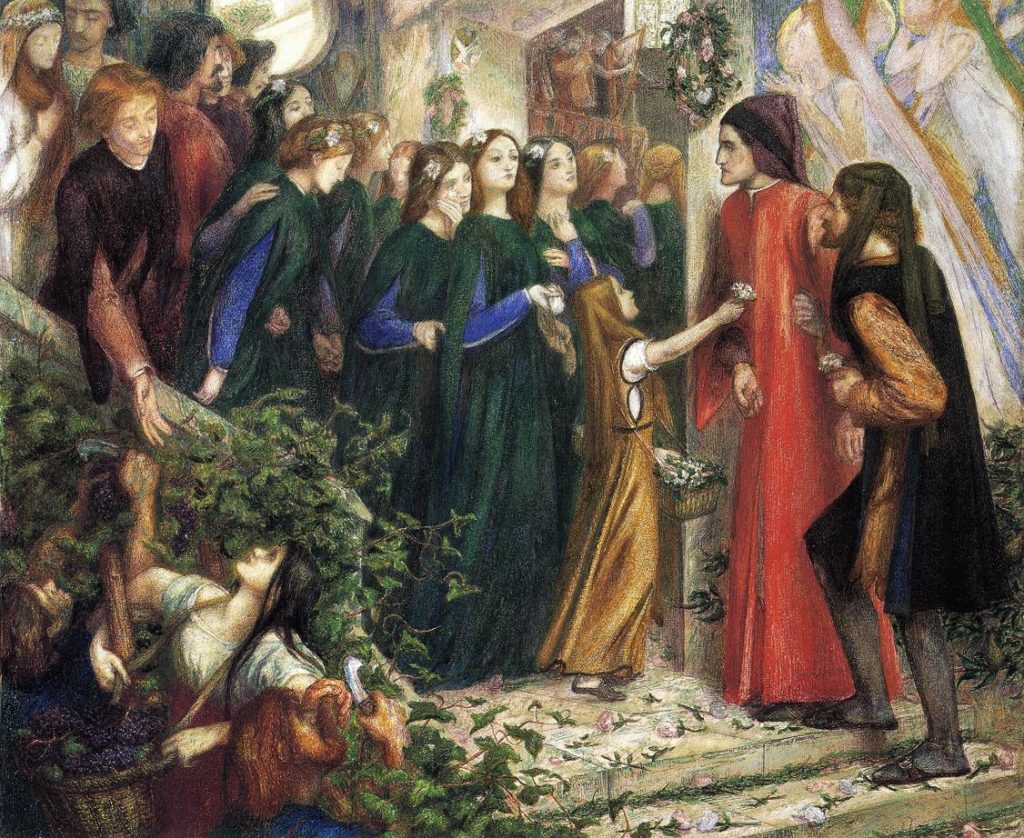
The relationship between Dante and figurative art is one of the topics critics have been most interested with in recent years. They have overcome some interpretative lines that in a too easy or generic way established links, influences, or reciprocities between works, themes, and contemporary images, coming to identify new hypotheses. These have enriched the topic and made it much more complex and articulated, but also more alive and interesting.
I would like to warn the reader in advance that the path they will take by reading this article will be as long and arduous as the one that Dante himself had to go through. However, as Dante knew a long time ago, the path to Heaven begins in Hell.
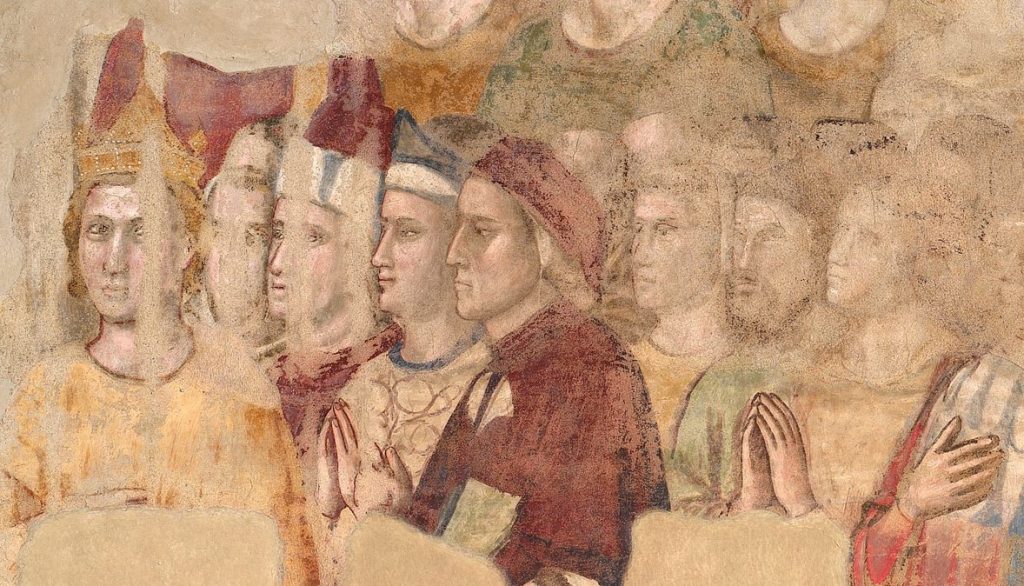
The oldest portrait of Dante Alighieri is in fact located inside the Chapel of Mary Magdalene at the Bargello Museum in Florence. It is attributed to the famous Giotto di Bondone and his school and was created between 1321 and 1337.
The chapel contains a fragmentary cycle of frescoes depicting Hell and Paradise, Stories of Saint Magdalene and Saint John the Baptist, as well as the portrait of Dante. On the entrance wall there is a representation of Hell while on the back wall, in the part depicting Paradise, Dante Alighieri is depicted holding the book of his Divine Comedy.
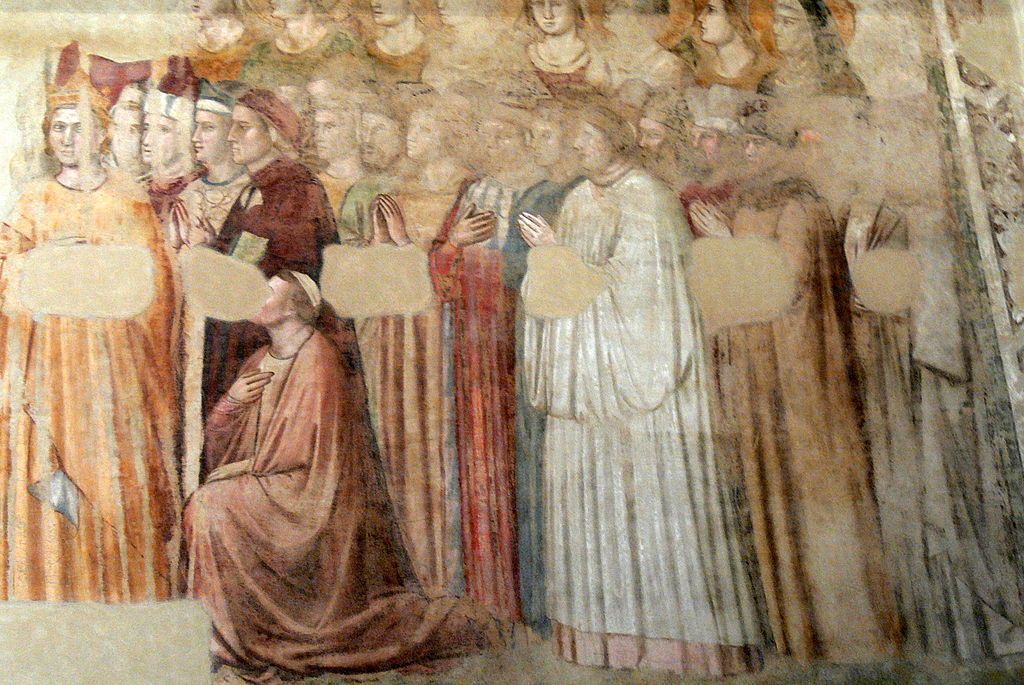
In 1570 the walls of the chapel were whitewashed and, over the centuries, a series of changes were made to the spaces of the chapel. When the murals were rediscovered in 1840, the pictorial cycle, and especially Dante’s portrait immediately became famous and the subject of various studies and restoration campaigns.
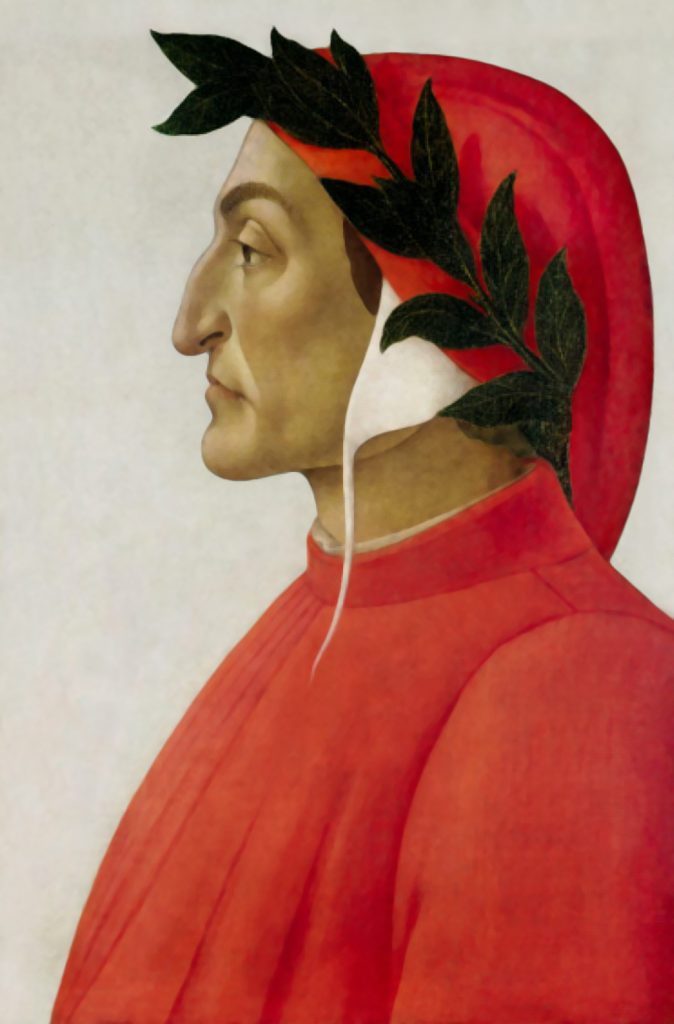
Sandro Botticelli‘s portrait of Dante from 1495 is one of the most renowned portraits of the poet in the history of art. It is not clear whether the work was made directly by the artist or it is the result of his bottega, but the final painting is indisputably made with great skill.
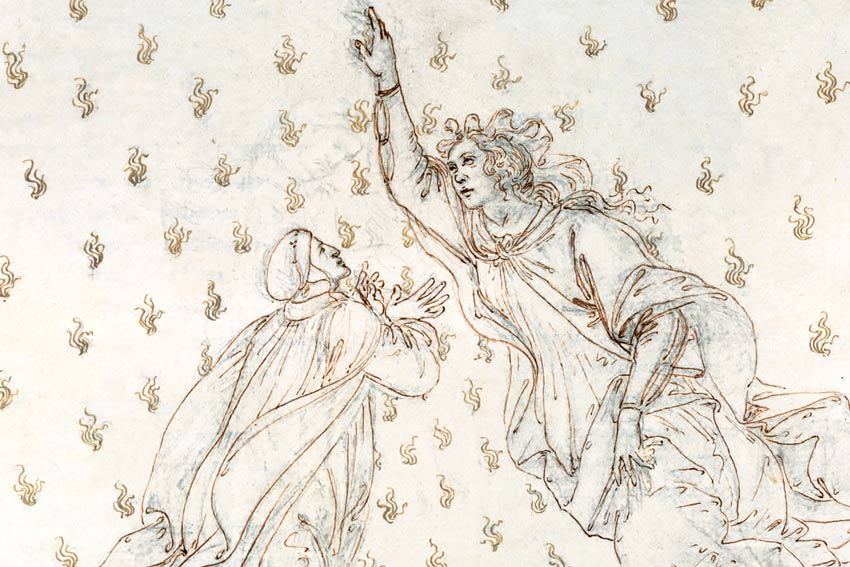
The Divine Comedy by Botticelli is one of the most beautiful and intriguing renditions of Dante’s Divine Comedy since the Renaissance. The commissioner was a member of the famous Medici family, namely Lorenzo di Pierfrancesco de Medici, cousin of the famous Lorenzo the Magnificent. The manuscript, also known as Divina Commedia con illustrazioni di Sandro Botticelli, was created and illuminated in the last quarter of the 15th century.
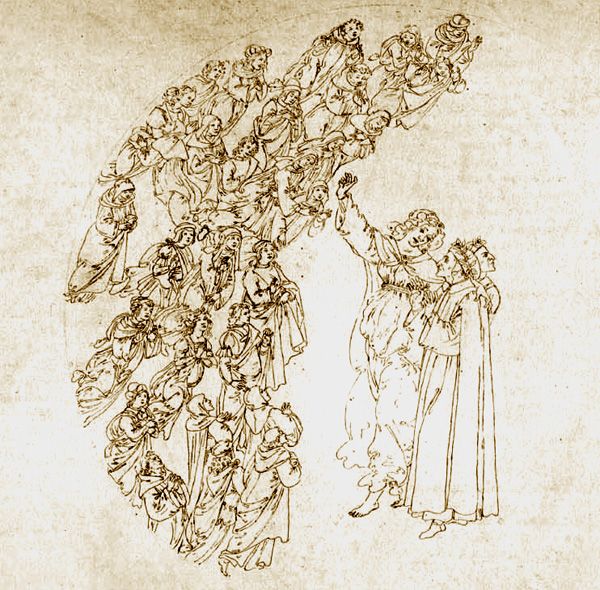
With its 92 silverpoint drawings, the manuscript is justly considered a Renaissance masterpiece. The most interesting part of the illustrations is Dante’s Inferno, a project that he carried out several times and that took him many years. The drawings, unfortunately, were left unfinished with only four of them being fully and completely illuminated such as The Map of Hell.
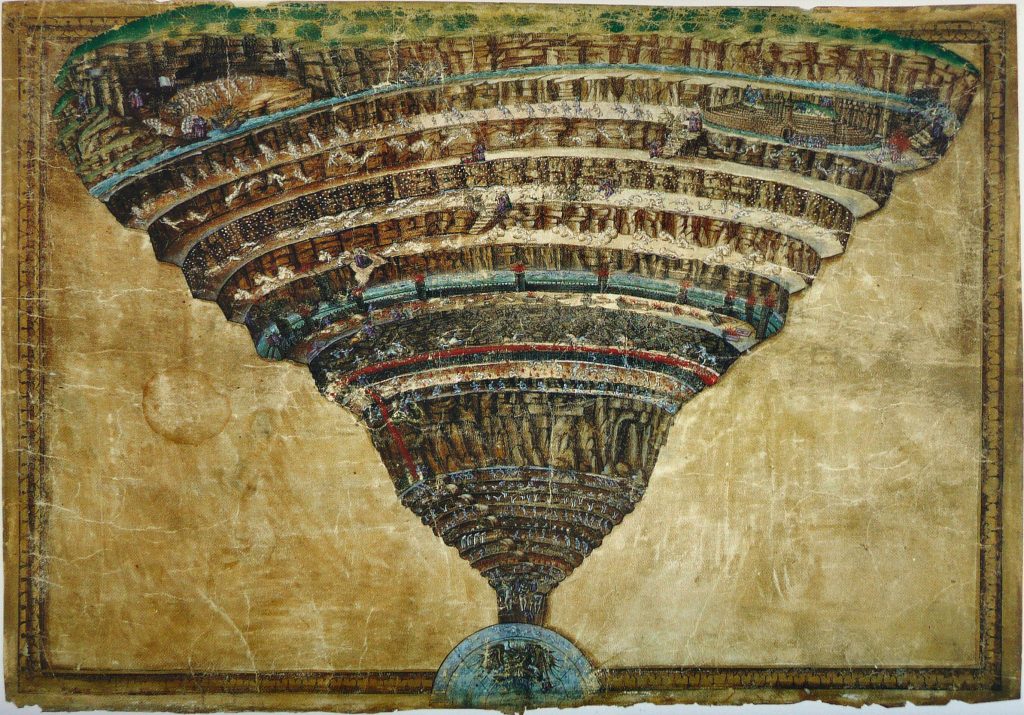
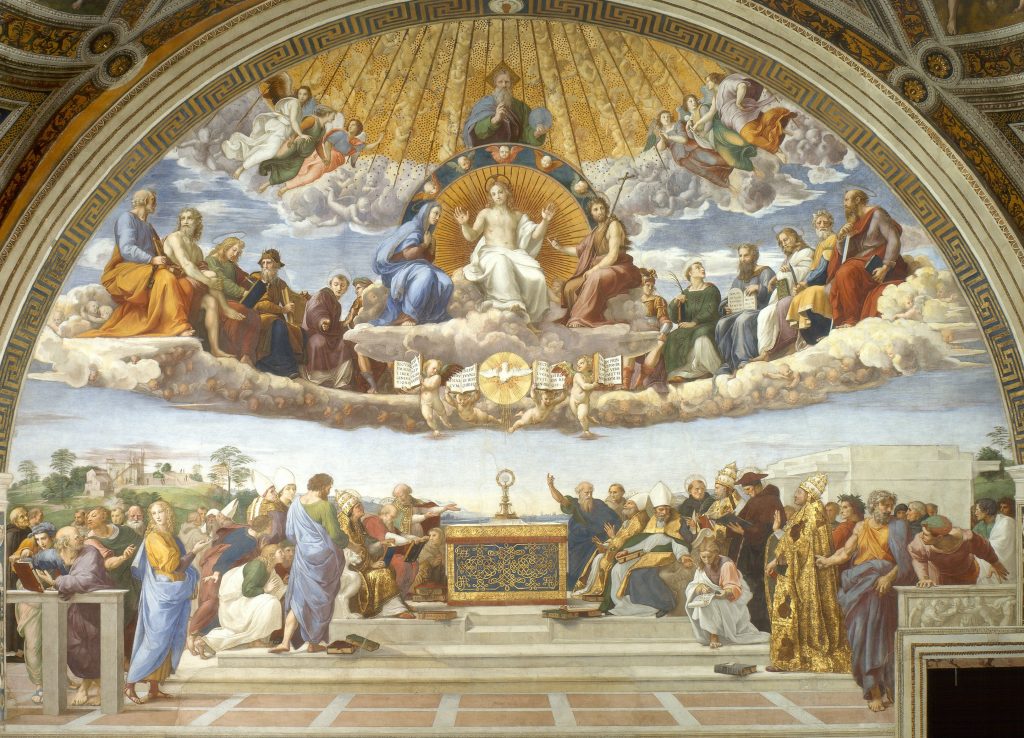
The work of Raphael, Disputation of the Holy Sacrament, created between 1508-1509 depicts the militant Church in the lower part, and the triumphant Church in the upper part. Furthermore, it is dedicated to theology, a discipline through which the soul can reach the truth.
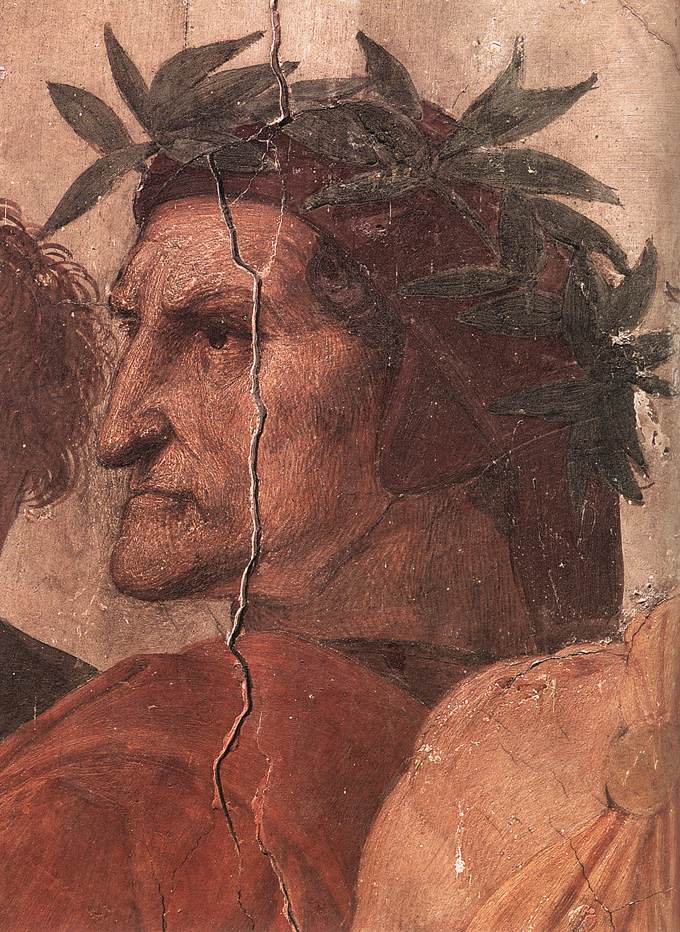
Even though not all the characters have been identified, a portrait of Dante Alighieri is found in the lower section, towards the right. He is part of a council in which we can see theologians, Doctors of the Church, and popes, but also philanthropists, writers, and simple anonymous believers.
Dante Alighieri is seated on a boulder facing left and holding, in the direction of the viewer, a large volume with open pages referring to the Canto XXV of Paradise. With his right hand, he protects Florence represented by his most important and representative buildings. The city is part of the terrestrial world while his gaze points towards the world represented by the Comedy. With a hooked nose and a protruding chin which makes him immediately recognizable, Dante looks into the distance towards a pyramidal mountain (Purgatory) that rises from the waters of a lake.
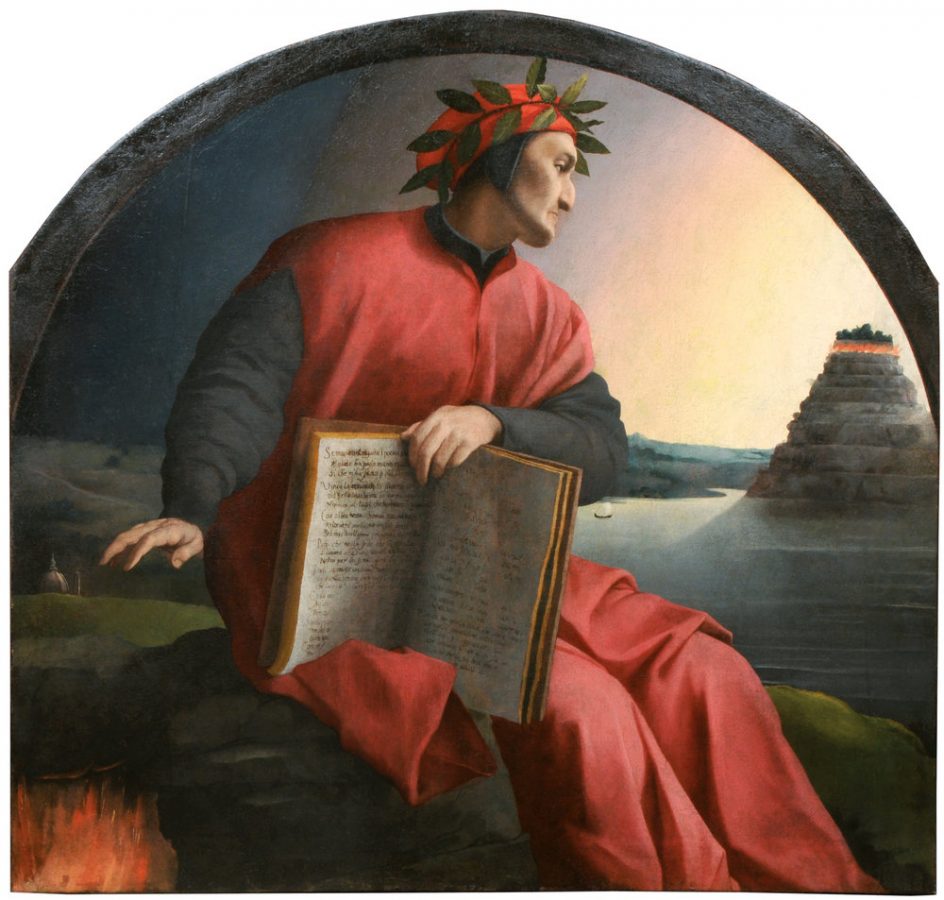
Agnolo Bronzino‘s painting offers us a different interpretation of the poet. For a long time it was considered lost until the canvas was found in a private Florentine collection and accepted by critics as the original portrait of Dante dated to 1530 and mentioned in Vasari’s biography.
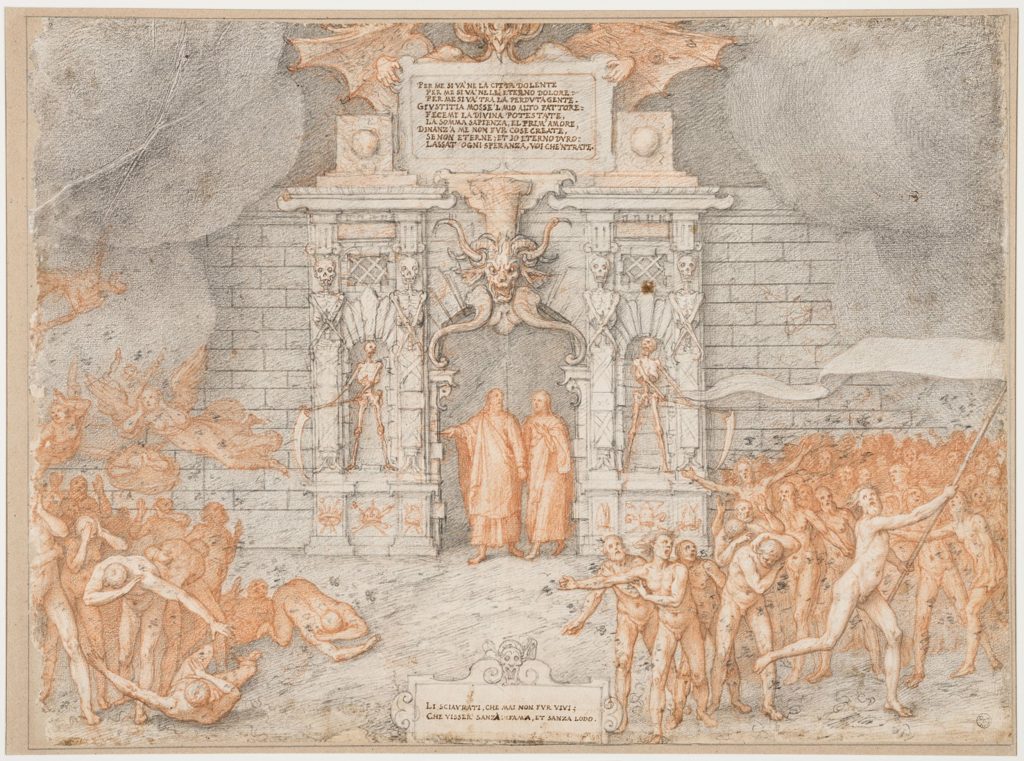
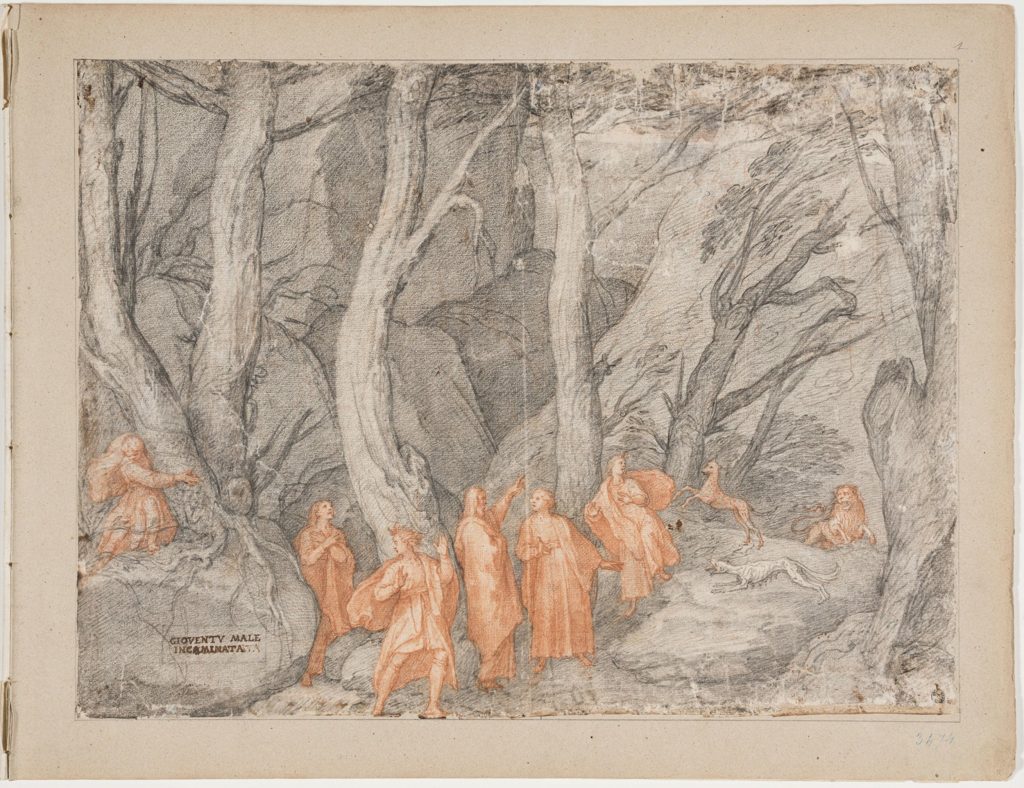
The 88 drawings, made by Federico Zuccari (a painter famous for painting frescoes on the Florentine dome Santa Maria del Fiore at the end of the 16th century), constitute the most impressive illustrative set of the Divine Comedy created before the 19th century. Made between 1586 and 1588, during Zuccari’s stay in Spain, the entire collection entered the Uffizi Gallery in 1738, thanks to the donation of Anna Maria Luisa de’ Medici.
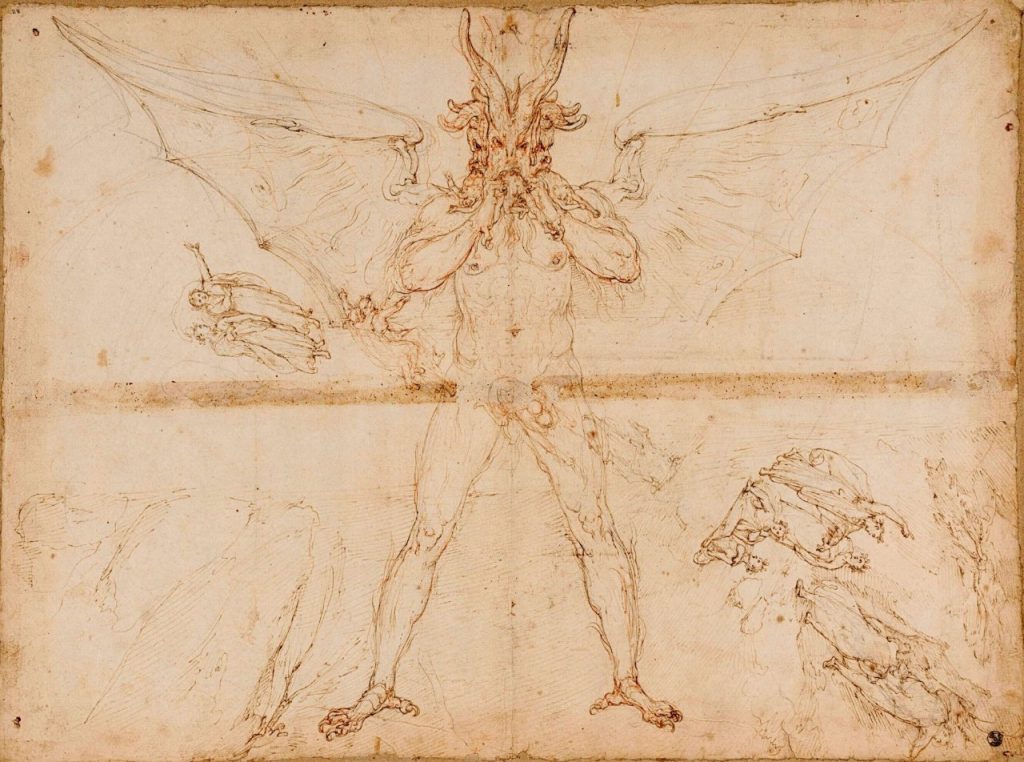
Paolo and Francesca is a painting by the French artist Jean Auguste Dominique Ingres, produced in seven known versions between 1814 and 1819. It derives from the story of Paolo and Francesca, the two ill-fated lovers from Dante’s Inferno Canto V.
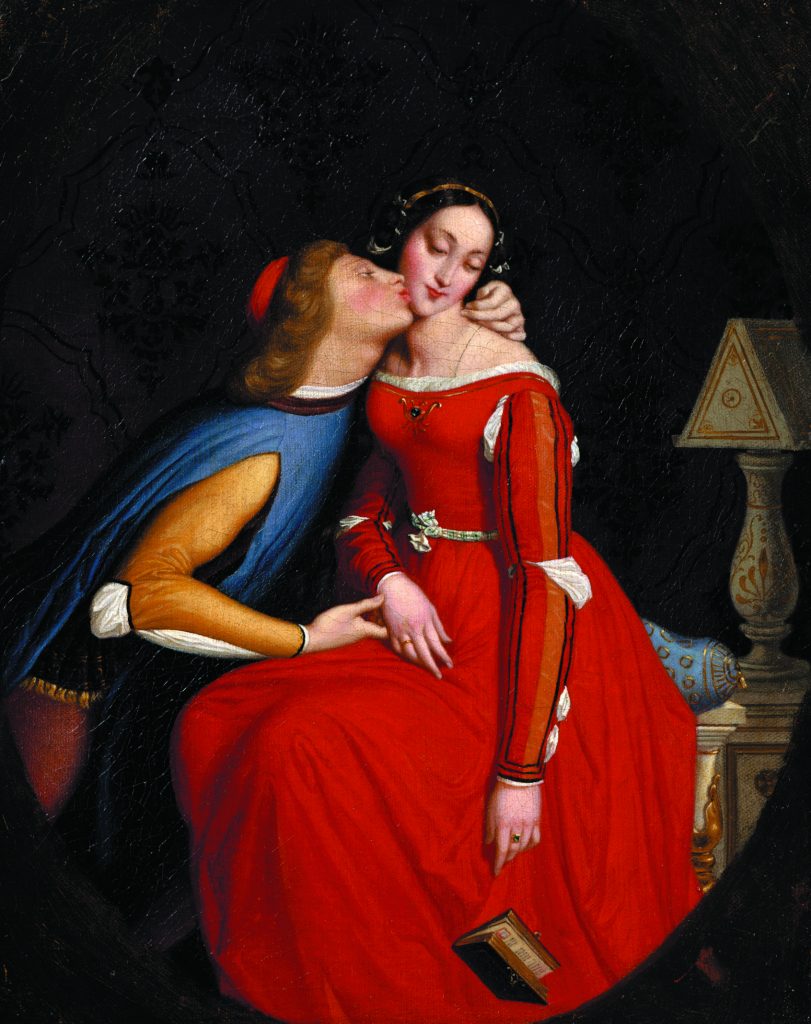
One day for our own pleasure we were reading
Of Lancelot and how love pinioned him.
We were alone and innocent of suspicion.Several times that reading forced our eyes To meet and took the color from our faces. But one solitary moment conquered us.
When we read there of how the longed-for smile Was being kissed by that heroic lover, This man, who never shall be severed from me,
Trembling all over, kissed me on the mouth. That book — and its author — was a pander! In it that day we did no further reading.
Dante Alighieri, The Divine Comedy, Canto V., Inferno. Digital Dante/Columbia University.
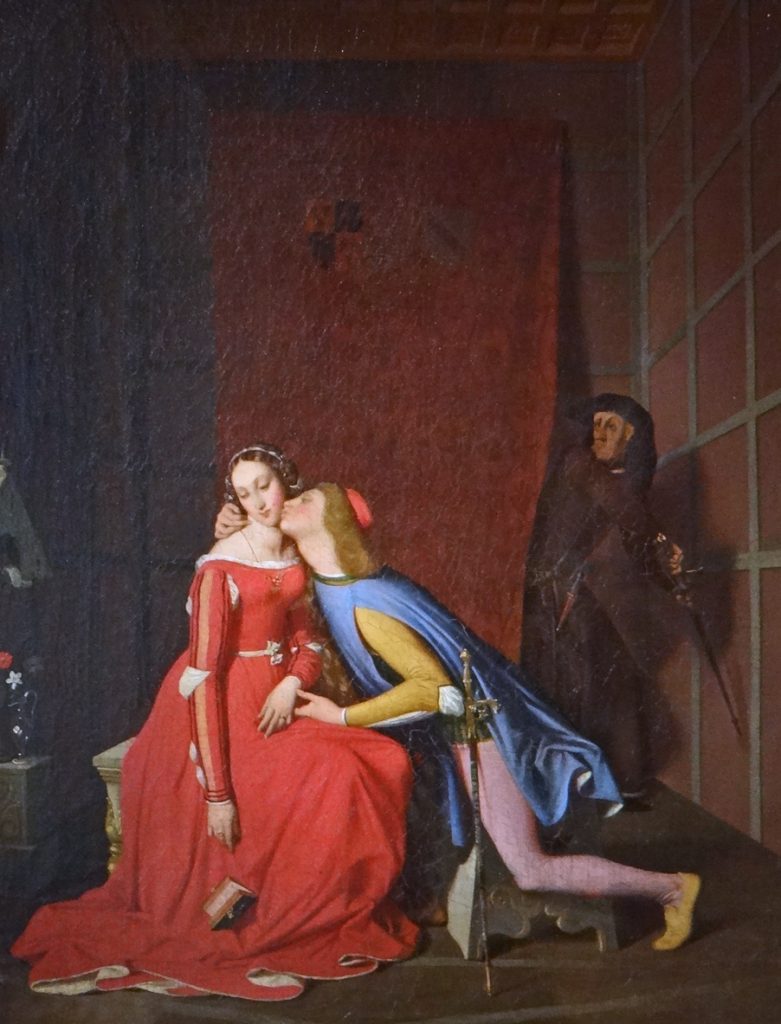
Of the seven known versions, that in the Musée des Beaux-arts d’Angers is considered the most complete, notably in the exaggerated form of Paolo, whose neck recalls the same artist’s painting of Jupiter and Thetis. In some versions Francesca’s husband enters the room in the background from behind a tapestry, in other versions, this detail is missing. The frontality of the composition and the details of the room and clothes refer to the Northern Renaissance.
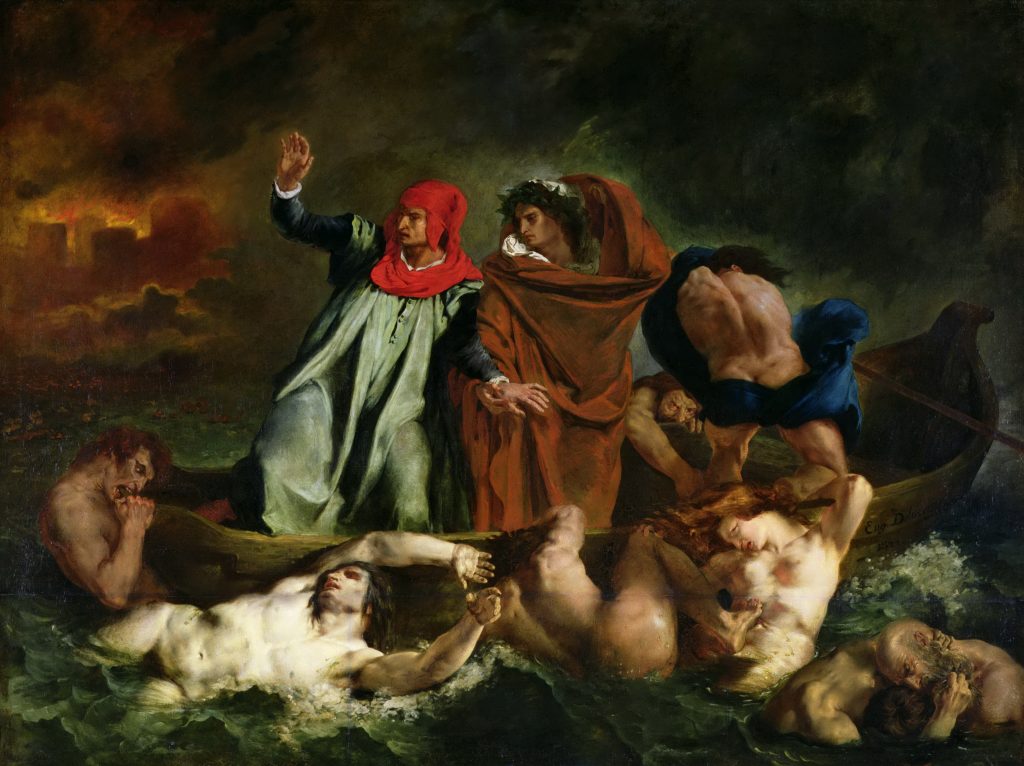
This beautiful Eugène Delacroix oil on canvas from 1822 entitled Barque of Dante currently hanging in the Musée du Louvre in Paris loosely depicts events narrated in Canto VIII. of Dante’s Hell. A leaden, smoky mist and the blazing City of the Dead form the backdrop against which the poet Dante fearfully endures his crossing of the River Styx. As his barque plows through waters heaving with tormented souls, Dante is steadied by his guide Virgil, a poet of Classical antiquity.
In 1824, Blake’s friend the artist John Linnell commissioned him to make a series of illustrations based on Dante’s Divine Comedy. Wiliam Blake was then in his late 60s and he designed 100 watercolors of this subject during a fortnight’s illness in bed, at least that’s what historians say.
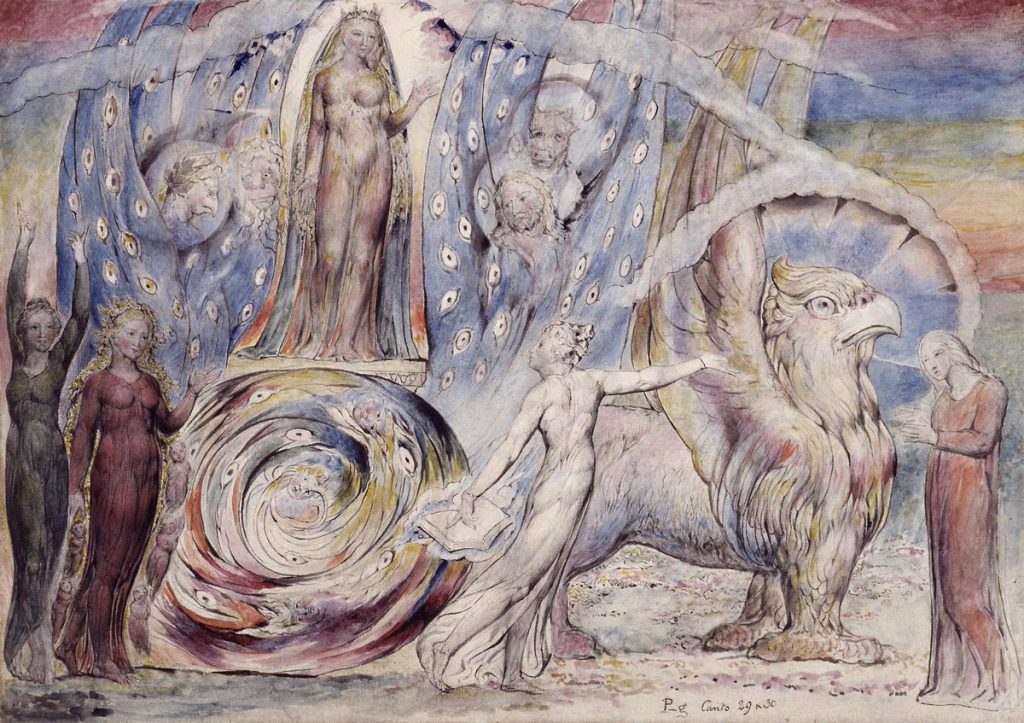
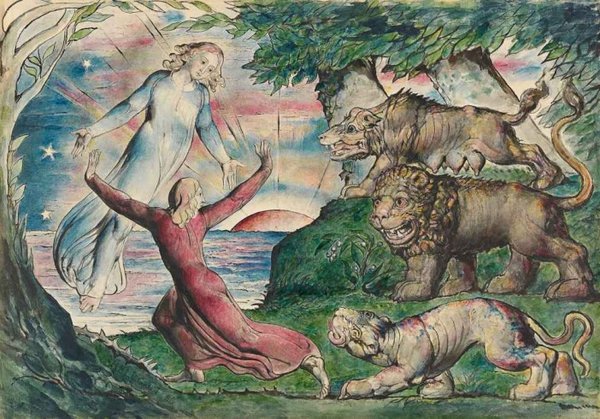
However, some illustrations of Paradise remain as unfinished sketches. The loss is less than it might be since Blake (like Gustave Dore and other artists who have illustrated Dante) found that Purgatory and Paradise offer much less interesting subject matter than Hell with all its perverse and bizarre punishments.
Dante and Virgil in Hell is an oil painting on canvas made by the French William-Adolphe Bouguereau in 1850 and is now kept at the Musée d’Orsay in Paris. The subject is taken from an episode of Canto XXX. of Dante’s Inferno.
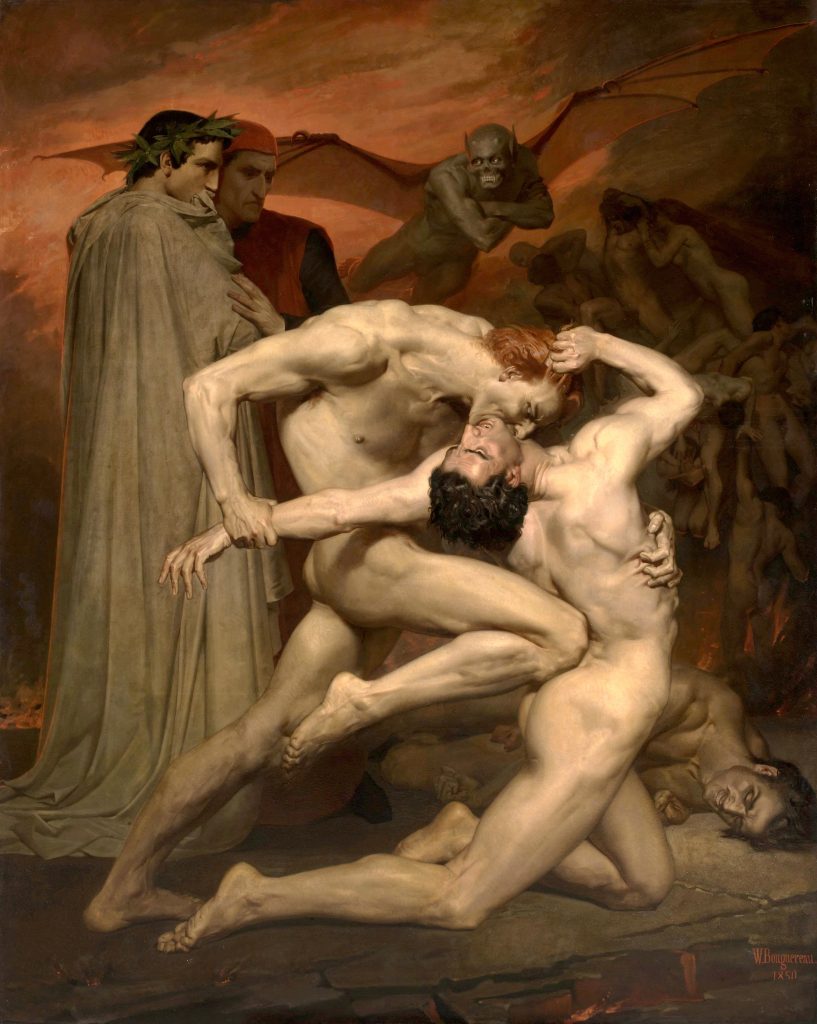
Dante and Virgil are in the tenth bedlam of the eighth circle, where forgers are punished. In the foreground are two of the damned, fighting wildly. The one on the left with red hair is violently biting the second’s neck and kneeing him in the back, causing him to bend over and fall. Behind them, on the left, the two poets look on with a terrified expression, while on the right a demon grins.
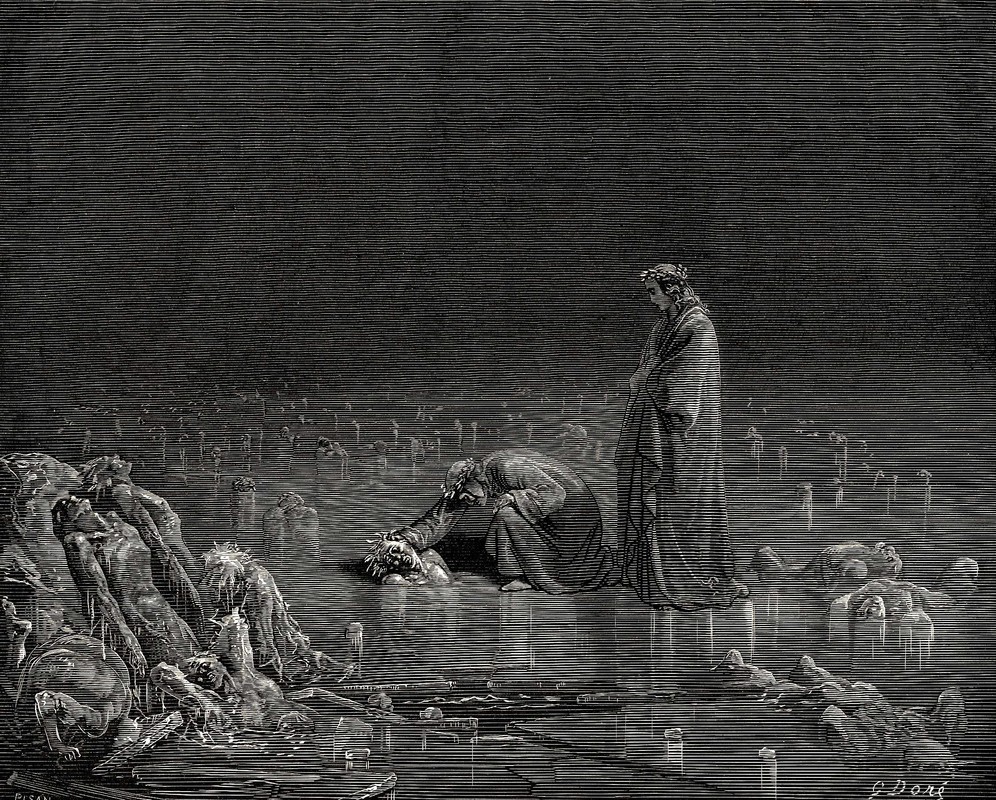
Gustave Doré’s illustrations and Dante’s Divine Comedy have become so intimately connected that even today (more than 150 years after their initial publication) the artist’s rendering of the poet’s text still determines our vision of the Commedia. Planned by Doré from 1850, the Dante illustrations were the first in a series he referred to as the chefs-d’oeuvre de la littérature.
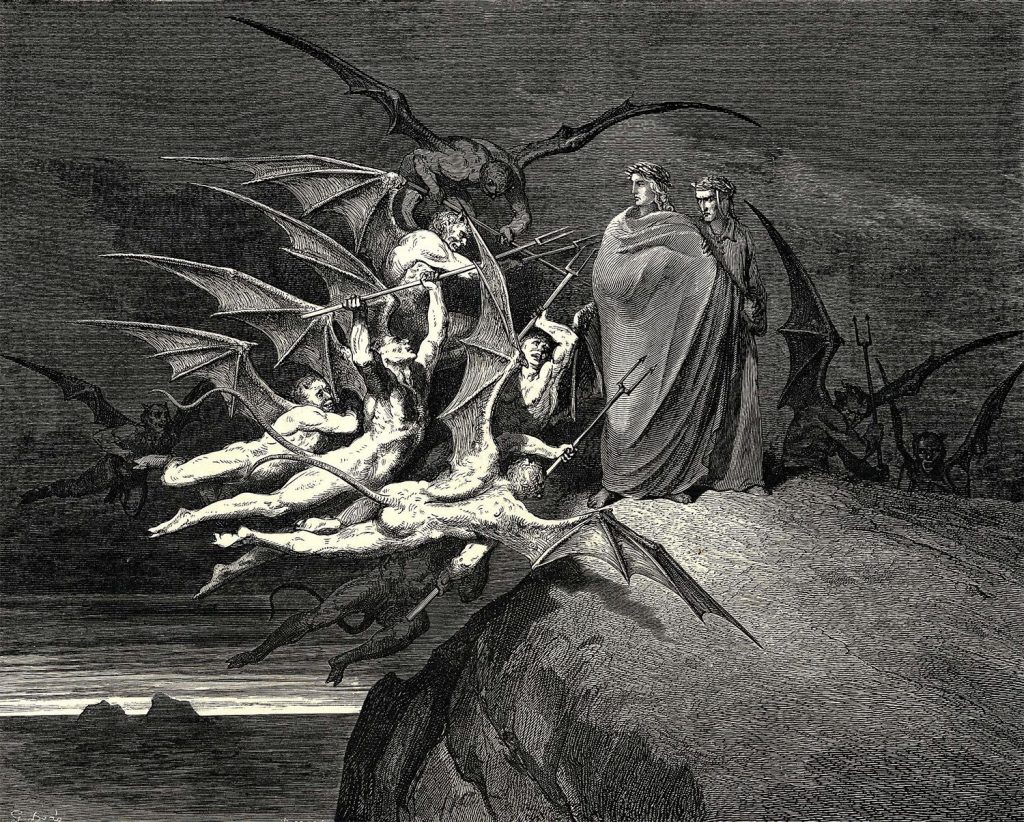
Characterized by an eclectic mix of Michelangelesque nudes, northern traditions of the sublime landscape, and elements of popular culture, Doré’s Dante illustrations were considered among his crowning achievements– a perfect match of the artist’s skill and the poet’s vivid visual imagination.
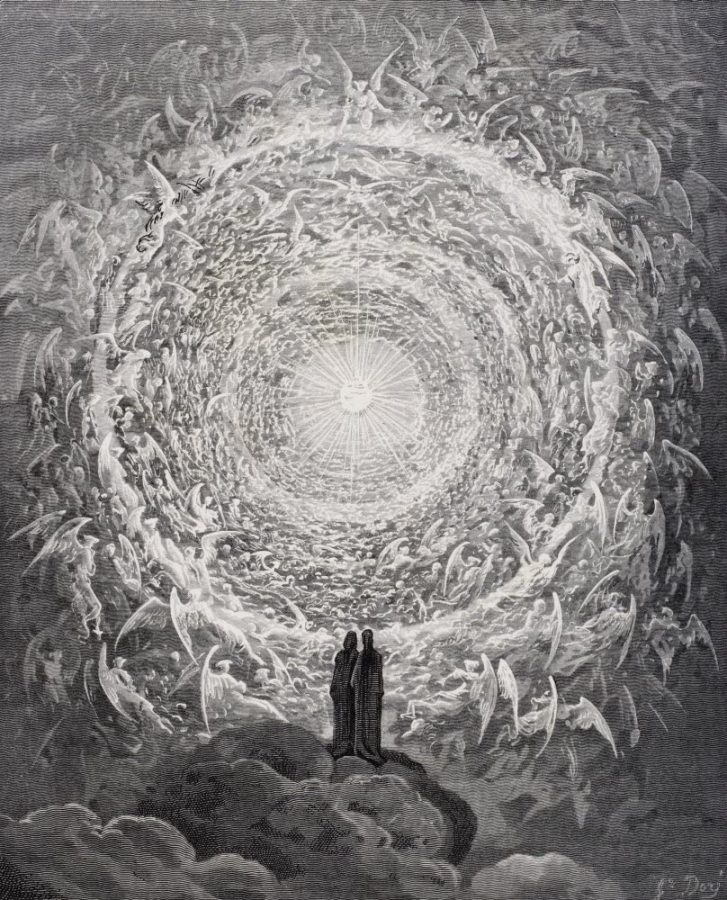
The placement of Dante’s Commedia at the top of this list reflects the poet’s popularity within mainstream French culture by the 1850s. The 19th century saw an expansion of interest in Dante’s work which resulted in numerous translations of the Divine Comedy into French, critical studies, newspapers, and specialized journals, and over 200 works of painting and sculpture between 1800-1930. Doré’s choice of Dante’s Inferno as the first of his proposed series of illustrated masterpieces of literature reflects the extent to which Dante had attained popular appeal in France by the 1860s.
Among the founders of the Pre-Raphaelite Brotherhood, Dante Gabriel Rossetti represents Beatrice, the woman loved by Dante who died prematurely. She lives in this painting through the spirit of Elizabeth “Lizzie” Siddal, the beloved wife of Dante Gabriel Rossetti who also died prematurely due to laudanum abuse. The painting from 1872 immediately makes us understand this parallel between Dante’s tragic, lyrical feeling for the death of his beloved woman and the profound despair that assailed Rossetti after Lizzie’s death.
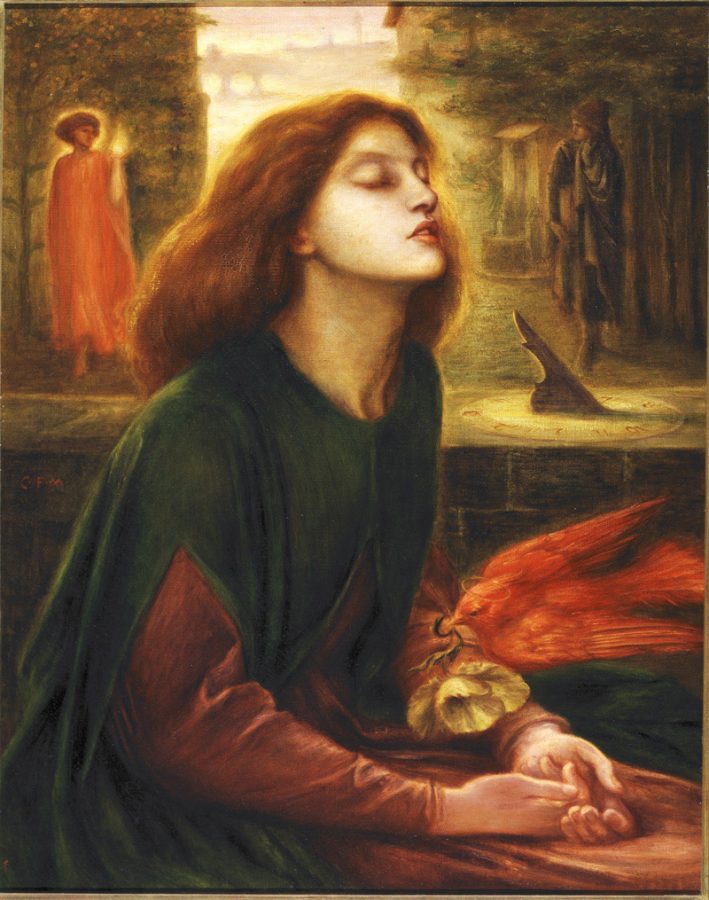
Beatrice Portinari as Beata Beatrix is depicted with flowing red hair and leaning against a balcony. The dreamy face, the lips just opened, the half-closed eyelids and the relaxed body are the ingredients used by Rossetti to define the mystical ecstasy in which the woman is placed. Her face has a livid complexion, alluding to her premature death, while her joined hands are welcoming a poppy flower, the symbol of death, in the mouth of a haloed dove.
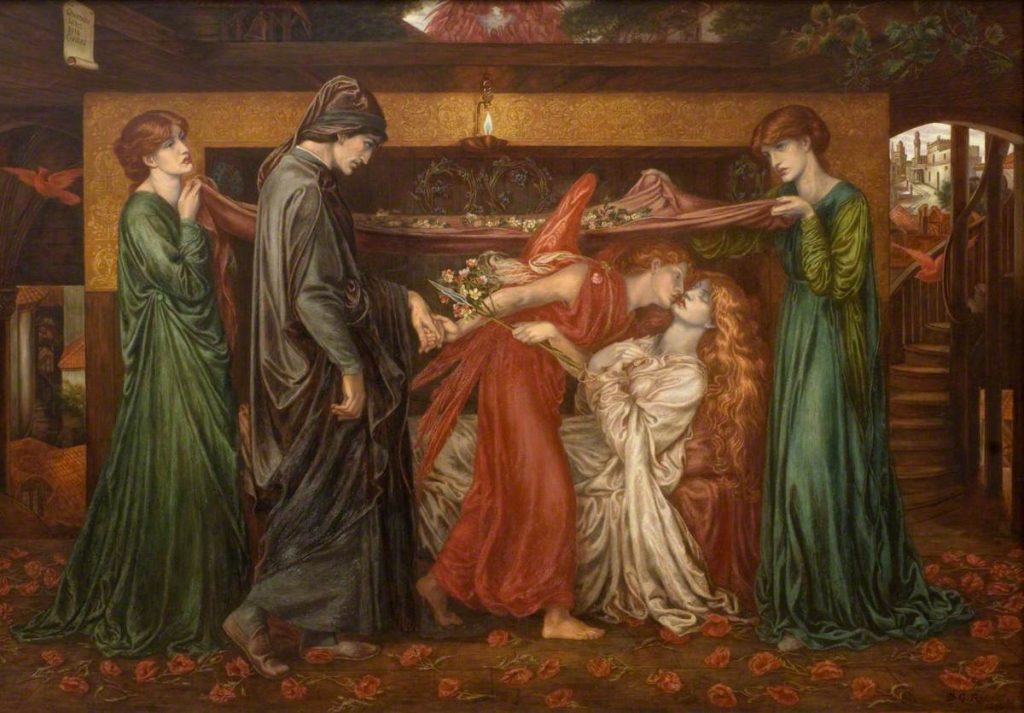
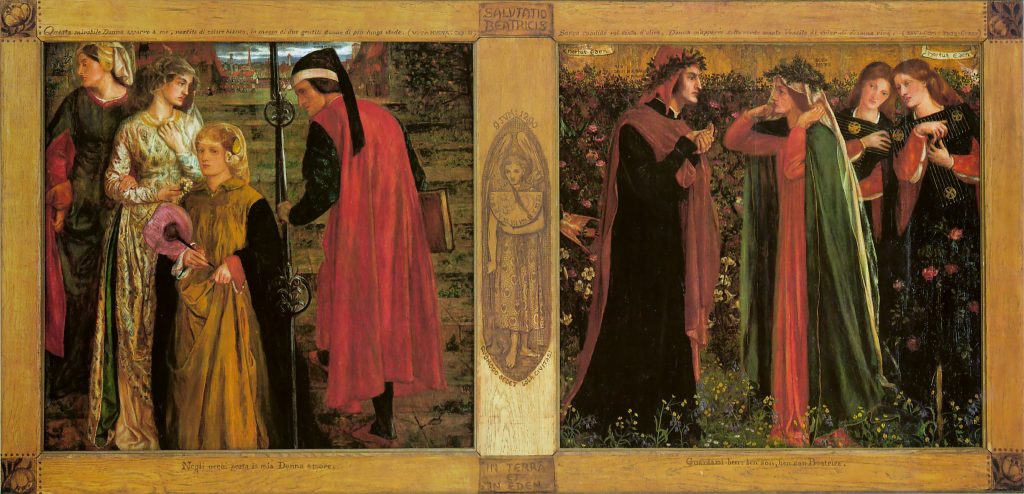
Rossetti also made other notable paintings inspired by and depicting scenes from the Divine Comedy or Vita Nova, such as Dante’s Dream on the Day of the Death of Beatrice or Salutation of Beatrice. In the last one, the meeting between Dante and Beatrice is represented in two moments, as he himself described in a letter. The painting on the left depicts the second meeting, in the presence of Love dressed in gold and holding a sundial in her hands, indicating the date and time of Beatrice’s death. In the painting on the right, however, the encounter of the two in Paradise is outlined, as described in the Divine Comedy.
The Gates of Hell, in French La Porte de l’Enfer, is a 6 metre high monumental sculptural group work by Auguste Rodin. It was created between 1880-1917 and depicts multiple scenes from Dante’s Inferno, containing 180 figures.
Several of the figures were also cast as independent free-standing statues like the Thinker (Le Penseur), also called The Poet, which is located above the door panels. One interpretation suggests that it might represent Dante himself looking down at the characters in the Inferno.
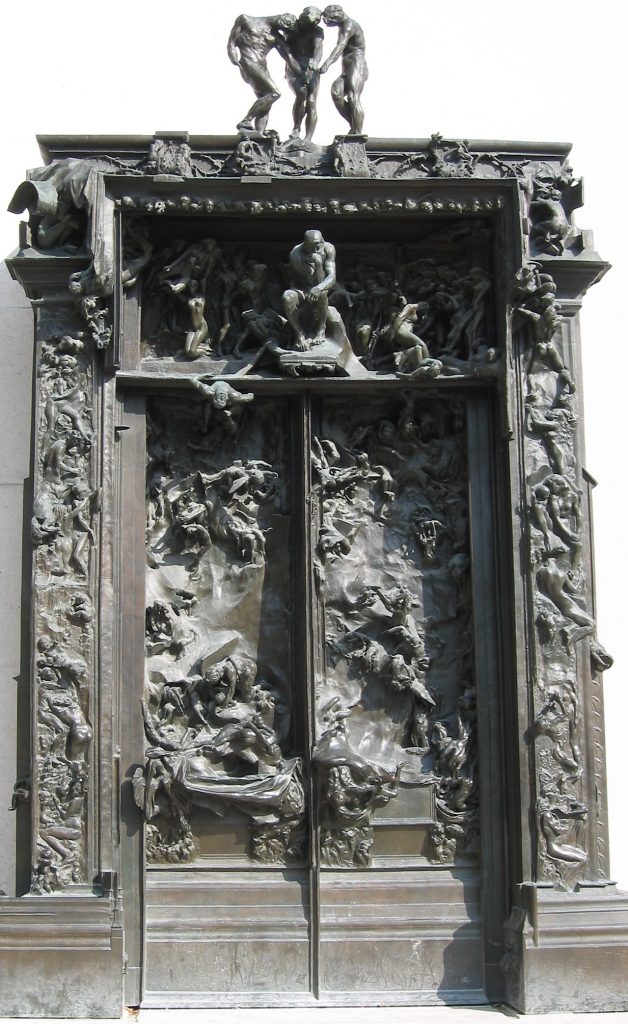
Fleeting Love (Fugit Amor), located on the right door panel, is one of several figures of lovers that represent Paolo and Francesca. Ugolino and His Children group, which was also cast as a separate bronze in 1882, depicts Ugolino della Gherardesca, who according to the story in Canto XXXIII. of Inferno, ate the corpses of his children after they died by starvation.
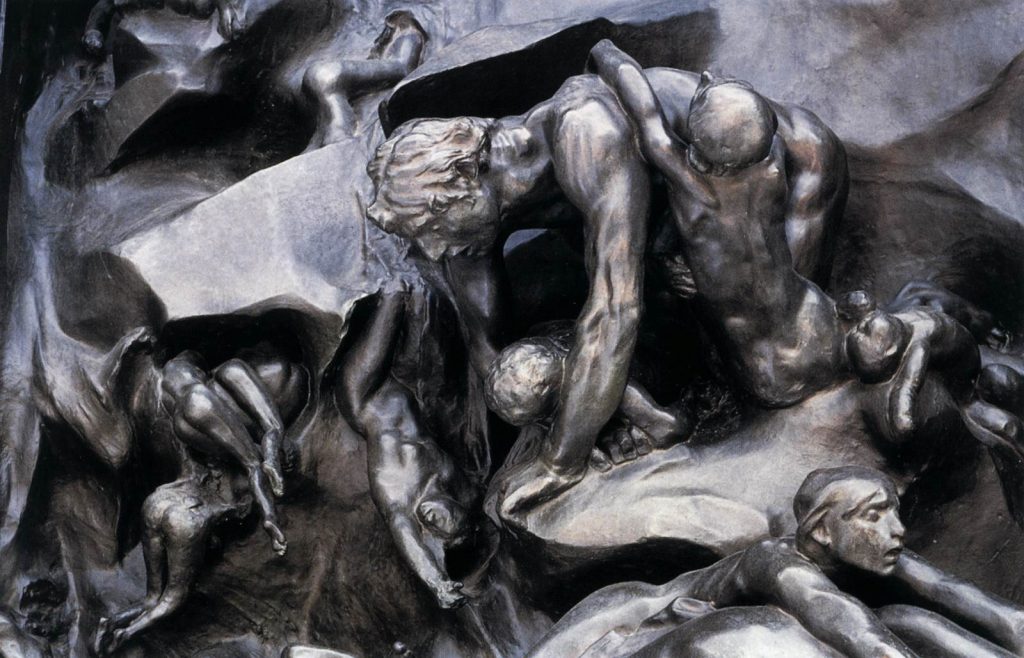
The painting Dante e Beatrice from 1882-84 by the British painter Henry Holiday, influenced by the Pre-Raphaelite school of art, refers to an episode in the Vita Nova. It reproduces Dante on the Ponte di Santa Trìnità in Florence meeting three women, among whom Beatrice emerges.
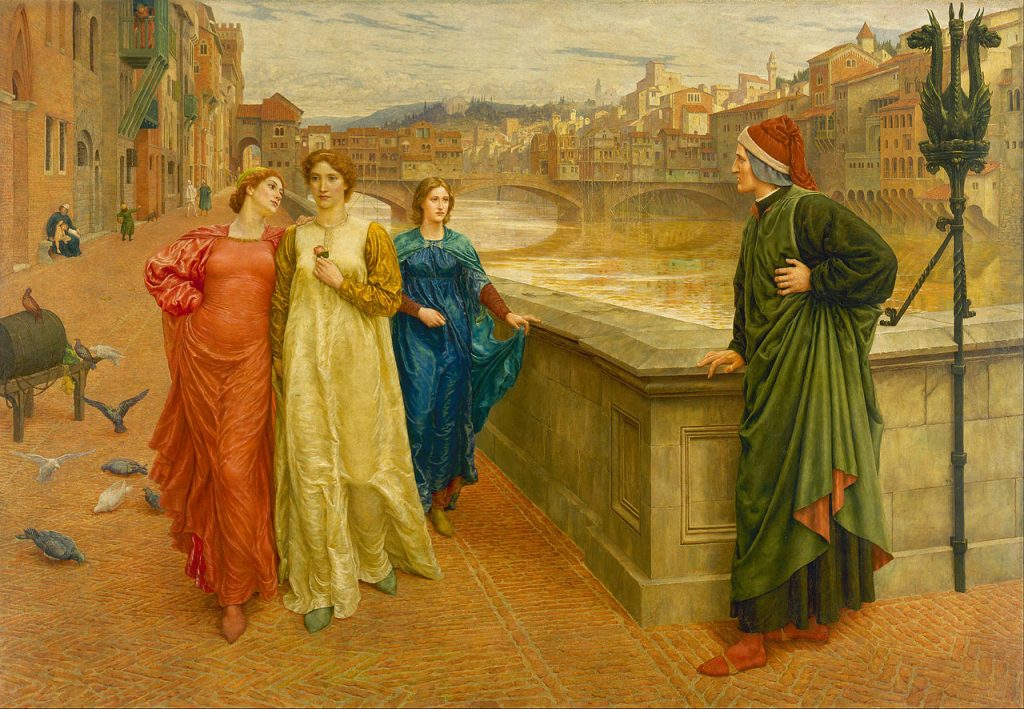
They wear clothes of the three colors representing respectively: red-charity, white-faith, green-hope. The one in the center wearing white is Beatrice who, however, refuses to greet him as previously. He pretends to turn his attention to the other women in order to hide his love for her and the consequent chatter of people provokes Beatrice’s indignation.
In 1881, Holiday traveled to Florence to make studies for this picture and carried out meticulous research to ensure that the correct buildings and architectural features were present.
(…) Just as the doves when homing instinct calls them
To their sweet nest, on steadily lifted wings
Glide through the air, guided by their longing…Dante Alighieri, The Divine Comedy, Canto V., Inferno. Digital Dante/Columbia University.

Famous Italian painter Umberto Boccioni, who was part of the Futurist movement, between 1908-1909 created the painting Il Sogno (The Dream) or Paolo e Francesca. He is already fully placing the figures in a Futurist dimension, reducing the descriptive part of the episode and transforming the embrace into a source of heat and energy, a sort of eternal lux.
Countless artists have represented the two memorable, lusty Paolo and Francesca, forever beaten by the perpetual storm that rages in the second infernal circle. Not even a Futurist painter like Boccioni has resisted the fascination of the two lovers subjugated by the convict book.
In 1950, to celebrate the 700th anniversary of the birth of Dante, the Italian government commissioned Salvador Dalí to illustrate one of the most important works of Italian literature, Dante’s Divine Comedy.
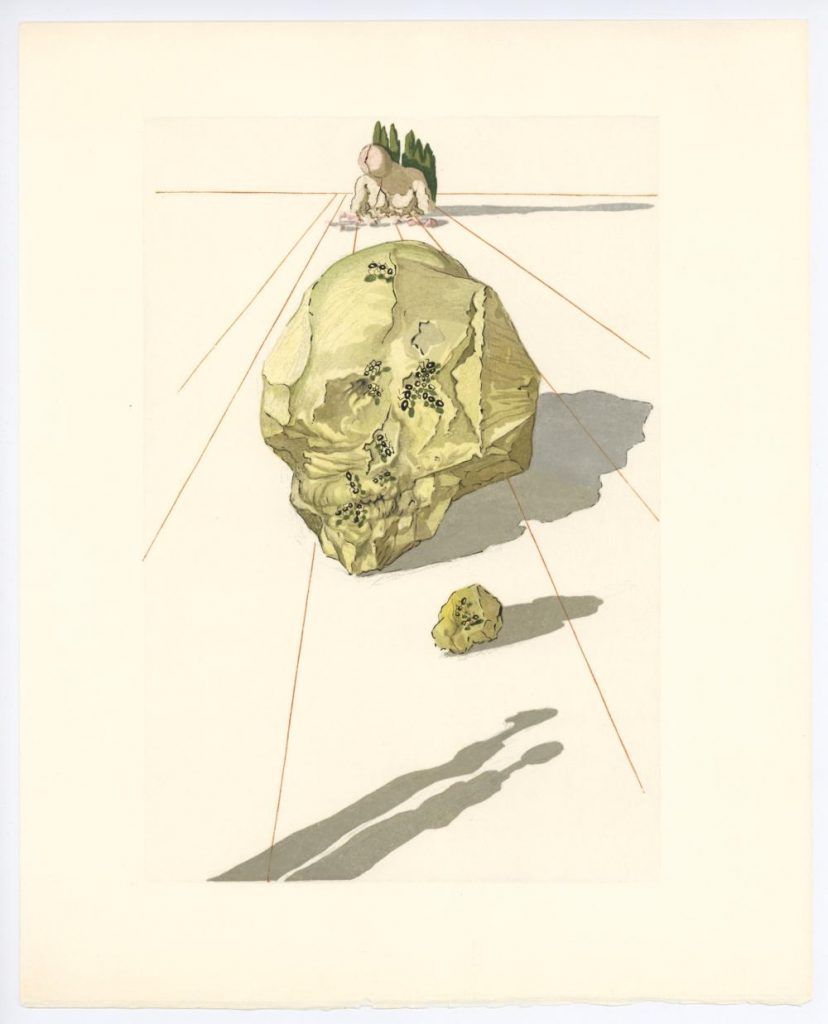
The illustrations are considered by many to be the most creative total body of work ever by Dalí. Dalí created 34 watercolors illustrating Inferno, 33 illustrating Purgatory, and 33 illustrating Paradise. In many respects, Dalí felt himself to be Dante. As Dante’s interpreter, Dalí felt obligated to follow the verses of the Comedy and, through his watercolors, not only explain but also reconcile the writing of Dante.
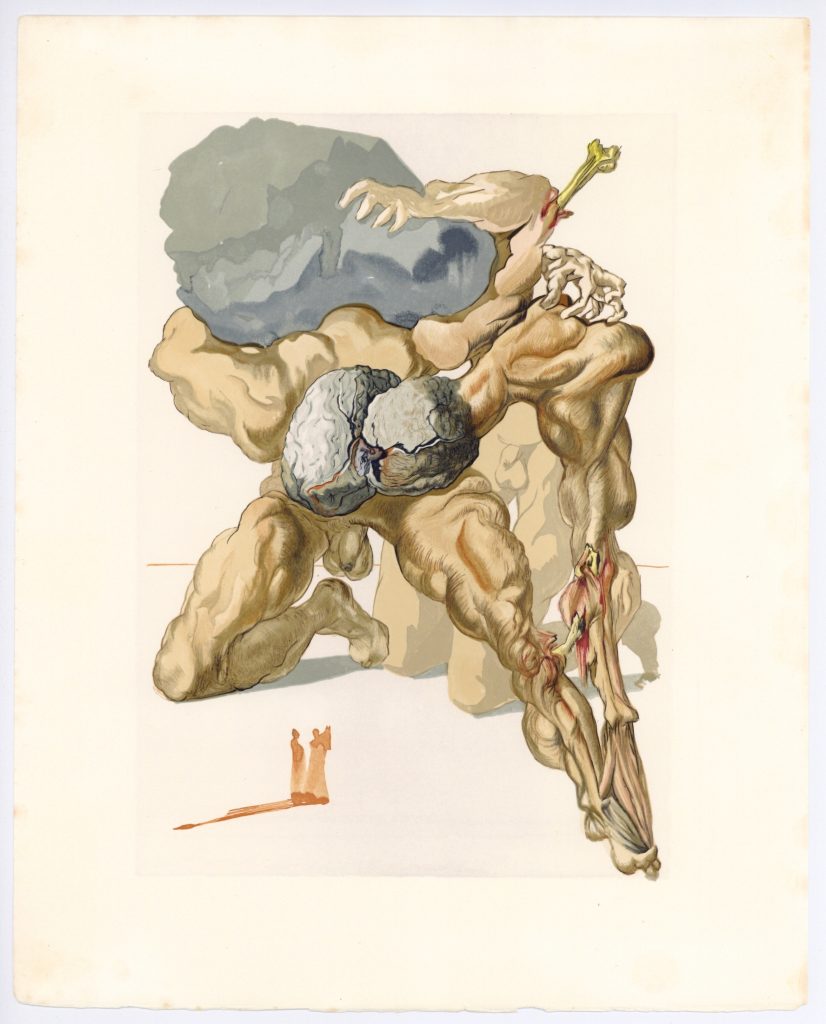
By attempting to pictorially take the viewer through Dante’s series of incredibly complex situations, he set himself a difficult task, one almost impossible to achieve. His fantasy flew and gave free rein to explore his own symbols and ghosts, so that, on many occasions, he went off the track of the images as Dante described them in the text. However, in many of the watercolors, Dalí was able to create powerful scenes, quite parallel to the fabulous poem, which were also striking as purely Dalí images by themselves.
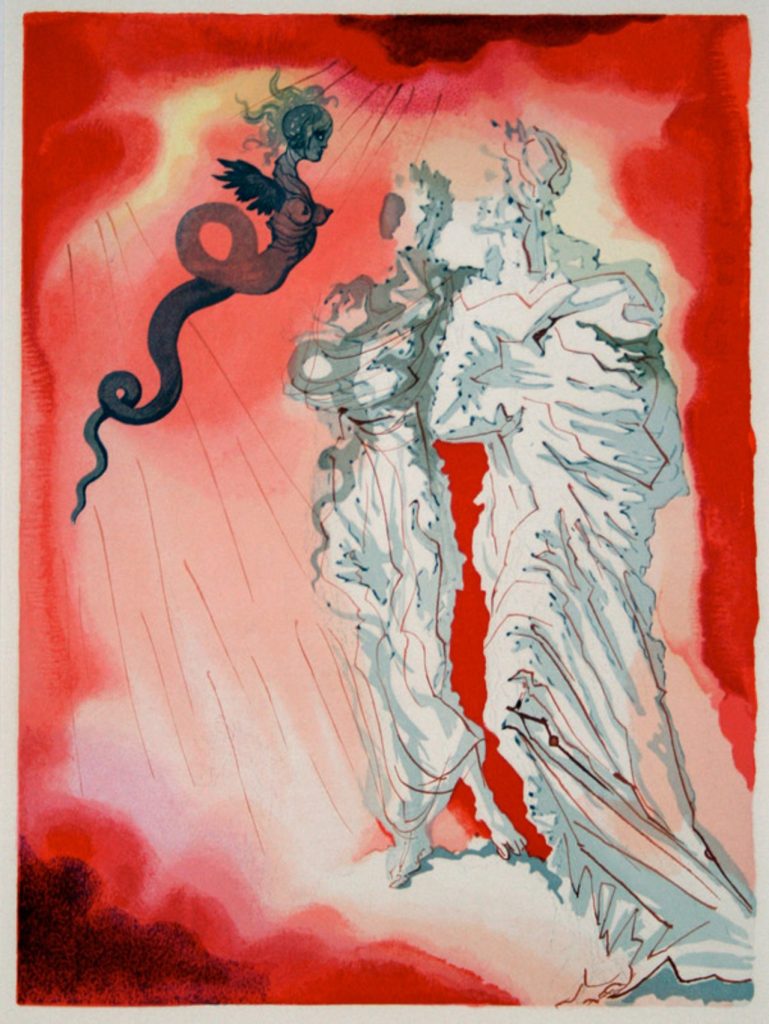
Dante Alighieri created a remarkable political, philosophical, and theological poem of great stylistic artistry and a real polyphonic masterpiece that shows moral wisdom and lofty ethical vision. His Divine Comedy has flourished for more than 650 years and in the simple power of its striking imaginative conceptions, it has continued to astonish generations of readers. Furthermore, for over a hundred years it has been a staple in all higher education programs in the Western world and it has continued to provide guidance and nourishment to the major poets of our own times.
It is in Dante’s reciprocal relationship with the reader to whom he has left, through his monumental masterpiece, an important legacy and enriched their mind through his work. The relationship, whether of a reader that has enlivened and resurrected Dante’s presence in the contemporary world by reading every word from the Divine Comedy, or of an artist who was able to create an idea about how Dante’s imaginary Hell, Purgatory or Paradise could possibly look through an artwork, which new generations of people will contemplate and which will keep Dante alive centuries after his death.
This is the greatest honor and success for Dante not only as a poet but mostly as a human being, that even after his own physical death he was able to secure his own immortality.
DailyArt Magazine needs your support. Every contribution, however big or small, is very valuable for our future. Thanks to it, we will be able to sustain and grow the Magazine. Thank you for your help!